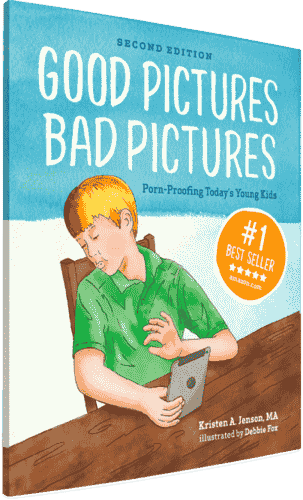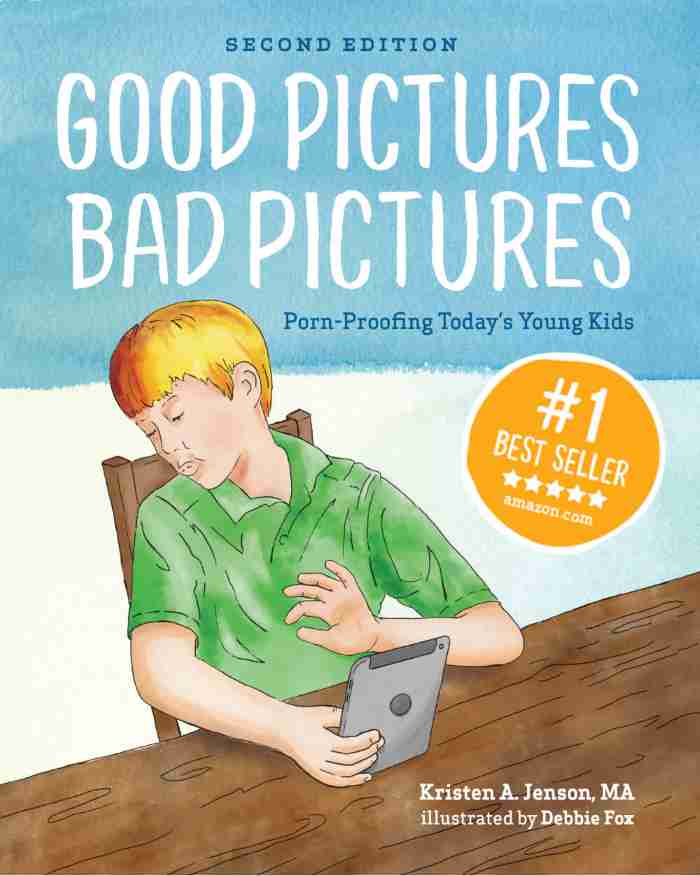

5 Ways Kids’ Brains are Super Susceptible to Porn
“What’s the most important thing to know about the effects of pornography on kids?” Dr. Jennifer Brown, mom to 5 growing boys, doesn’t hesitate to share her well-founded opinion on that question! She insists that parents and policy makers need to understand 2 facts:
- First, recognize that kids’ brains process porn different from adults, and
- Second, that kids’ brains are more vulnerable to porn.
Why does this matter? Because when we really get the facts straight, we come up with better solutions to protect children —not just in our homes, but also our communities. In fact, what Jennifer learned about the impact of pornography on kids has already helped create new government policies with the best interests of young people in mind. And it can help you improve your family strategies too!

Proactive mom was determined to make a difference for kids
Jennifer spent years reading through published research about the development of children’s brains and bodies. She was on a quest to understand how pornography could affect growing kids. Her findings motivated her to advocate for better public policies to protect kids. She even helped her home state of Utah declare porn a public health crisis (the first state to do so!) And remember, she’s a mom of five kids (ages 4 to 12), so she has plenty of opportunities to practice what she preaches.
We had a lot to talk about! Let’s start with her studies.
The brain’s natural safeguards are under construction during childhood and adolescence
We get it . . . porn is harmful! So why does it help to understand how it impacts the brain?
If you’ve read Good Pictures Bad Pictures: Porn-Proofing Today’s Young Kids you’ll recall that pornography acts like magnet to the brain. It pulls viewers in to look — even when they find the images disturbing or frightening.


Good Pictures Bad Pictures
"I really like the no-shame approach the author takes. It's so much more than just 'don't watch or look at porn.' It gave my children a real understanding about the brain and its natural response to pornography, how it can affect you if you look at it, and how to be prepared when you do come across it (since, let's face it... it's gonna happen at some point)." -Amazon Review by D.O.
That’s because sexually explicit content triggers a physical response in the body — a chain of events that ultimately floods the brain with unnaturally high quantities of chemicals (dopamine among others). In a split second, intense messages of excitement and euphoria are sent through the body. It’s important for parents understand that whatever response their child may have to porn, it’s a natural result of their biology.
“Porn just impacts young people in such a bigger way. There are very specific things about the adolescent brain that make it different from an adult brain.” — Dr. Jennifer Brown
Adults brains' have safeguards in place to protect them from being tricked by these chemical messages. But in the child and teenage brain, these safeguards are under heavy construction. This is what makes kids more vulnerable to the pull of pornography than adults. When pornography is viewed habitually at younger ages it could drastically interfere with normal brain development.
Related: How Porn Use Becomes an Addiction (Simplified!)
5 ways kids process porn differently than adults
Growing kids are under construction! Jennifer outlines 5 big construction zones of young brains. She encourages parents to keep a mental list of these zones. That way parents can encourage healthy brain development while considering the impact of the activities their kids are participating in.
Construction Zone #1: Underdeveloped prefrontal cortex
The brain’s ability to reject signals from pornographic content occurs in the prefrontal cortex. That’s where all rational thought patterns and self-control take place. But this area of the brain isn’t fully developed until the early-to-mid-twenties. That means when kids are exposed to pornography they don’t always have a natural ability to make safe, healthy decisions on their own. Especially when they are being ambushed by pornography.
Construction Zone #2: Dopamine in overdrive
The next hurdle a young brain has to overcome is the system that seeks and receives pleasure (often referred to as the reward pathway or dopamine system). When kids reach puberty this system goes into overdrive! That means youth exposed to pornography actually feel more and get a higher hit of dopamine then an adult. Dopamine cravings are also stronger at this age, putting young people at higher risk for addictions.
Construction Zone #3: Imbalanced stress response
As the adolescent brain matures, its stress response system becomes unbalanced. This causes the system to respond more quickly and for longer periods of time once triggered. Pornography is an expert trigger of stress! A release of cortisol puts the system into action. This has a double effect on the brain. First, large amounts of cortisol further impair the “thinking brain” (prefrontal cortex) and second, it can increase feelings of anxiety or depression.
Construction Zone #4: The organizational window of adolescence
Repeated exposure to porngraphy increases production of testosterone and cortisol. These steroid hormones have a significant impact impact on what’s referred to as the organizational window of adolescence (a very sensitive period of brain development). Too much exposure to pornography when young will allow these stress hormones to subtly rewire the brain. Changes that occur in adolescence can influence the brain’s emotional responses clear through adulthood.
Construction Zone #5: Increased testosterone levels
Testosterone levels are at their natural peak during adolescence. As such, so is sexual anticipation. That means that when young people, particularly teen boys, are exposed to pornographic content their sexual response will be much higher than that of an adult. They will also have increased feelings to act out on what they are seeing — further increasing their level of sexual anticipation.
Important! Does this all sound overwhelming? Deep breath! We’ve only described what could happen when a child or teen’s use of pornography is left unchecked. This study was not designed to take into account the significant role that parents, grandparents and youth leaders have in helping kids rewire their brain to overcome habits of porn use. Love, persistence, effort and faith are powerful tools!
Building a case for porn as a public health crisis
All of Jennifer’s findings can be found in this research paper, which was prepared to show that pornography is a serious health risk to young people.
Interestingly, Jennifer is a dentist in her professional practice. What pushed her to devote so much time to study the brain?
In her own words: “I felt like we needed to focus on science as we engaged in this battle.”
Jennifer could have stopped after the study - but she moved on from the library to the legislature! She had never been involved in political action before. Yet the facts Jennifer uncovered motivated her to push for better laws to protect kids.
“About 5 or 6 years ago I started contacting my local Senator, Todd Weiler, asking him to take a stand against pornography. Initially he was reluctant to do much about this issue — but he will tell you how I kept bugging him about it. Finally, I wrote a letter that was really ‘quite to the point’. I told him that he really had an obligation to protect our youth.”
Senator Weiler and Jennifer ended up working together on many legislative changes.This dynamic duo has influenced their State Legislature to pass a bill or resolution concerning pornography in every session since their first meeting:
- Library Bill: Mandated filtering — including WiFi — in all libraries.
- Custody Bill: If a parent has intentionally exposed a child to pornography, that can be taken into account when determining custody situations.
- Internet Provider Bill: ISPs have to send out a letter and let their consumers know what options they have for filtering pornography.
- Resolution Regarding the Impact of Adult Images on Children’s Development: Recognizing that both softcore and hardcore porn negatively impact brain development of children.
- Resolution on the Public Health Crisis: pornography was declared to be a public health crisis (Utah was the first state to declare this. It cause enormous media uproar! Since then many other states have pass similar resolutions.)
This is an incredible example of what one parent can do to affect community wide change.

How does an anti-porn advocate teach her own kids?
Jennifer keeps working with lawmakers in her community to take greater responsibility for the safety of young people. But she is quick to admit that the most important conversations on this subject take place in our own homes.
Kids need parents who understand the unique qualities of developing brains. It helps motivate us to keep preparing our kids! Here’s how Jennifer and her husband, Mike, carry on the conversation at home:
- We start with our family technology plan.
- We talk about why their brain needs extra care to grow healthy and strong.
- We decide on the kind of media that we can all enjoy together.
- We discuss why some media is harmful to the brain.
- We have made a decision to hold off on social media until our kids are older.
- Talking openly means we are all on the same page at the end of the day.
”As our kids grow it’s important to continually reassess how they’re doing and how our media plan is keeping up with new technologies. We come back to the conversation every 3 to 4 months to have a relaxed discussion together. We find the more upfront and honest we are about the potential risks, the more open they are to discuss ways to stay safe.”
“It’s important to keep it comfortable and involve kids at their level of comprehension. I think the last time we did this we were all sitting on my big bed. Some of the kids were definitely more attentive than others. For me it’s just as important to start the habit of talking openly as to have a productive family meeting.” — Dr. Jennifer Brown
Act now to protect kids from the effects of pornography
We know that online pornography aggressively targets young viewers. What can we do to ensure our kids stay safe? Science helps us understand why kids are so vulnerable to the pull of pornography. Kids love science! We can come alongside our kids and help them so they can:
- Understand that they are special - their brain works differently from an adult’s because they are growing.
- Recognize that bad pictures are physically harmful to their brain as well as emotionally and socially damaging.
- Strengthen their thinking brain (prefrontal cortex) using the CAN DO Plan.
- Choose to protect their brain by making smart media choices with parents.
So talk about some of these ideas with your kids today and help them take charge of what affects their amazing brains!
Share your thoughts about this post with other parents in our Protect Young Minds - Parent Discussion Group on Facebook.
Parents may find talking about healthy media choices with their kids is a natural time to lead into a discussion about the harms of pornography.









